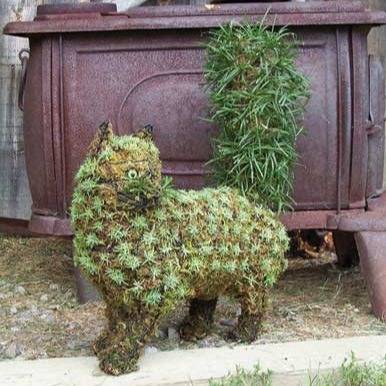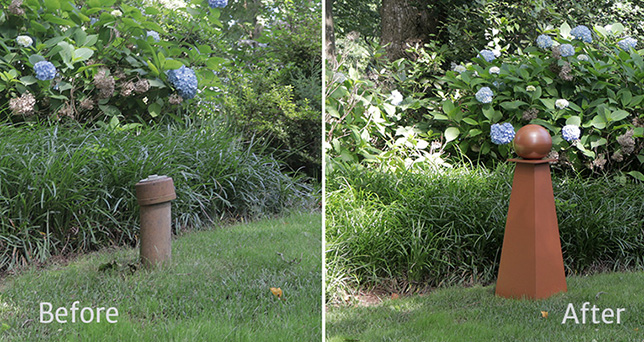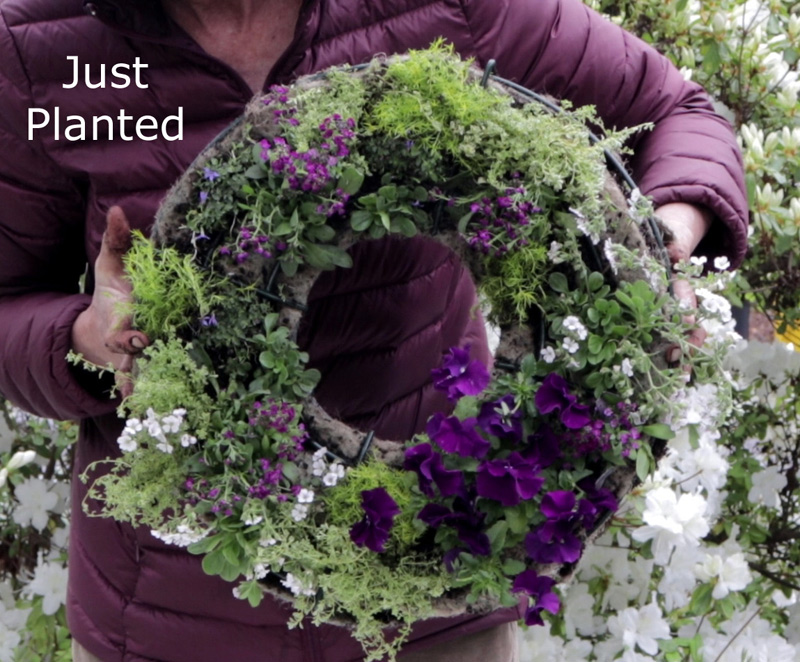Topiary, from the Latin topiarius meaning a landscape gardener of topia or “places,” is the practice of training shrubbery and trees into shapes and forms. These forms can range from the classic ball or cone to animals of all shapes and sizes. Topiaries are seen in miniature as well as towering hedges and shrubs. Topiaries have long been considered stately fixtures of a classical garden, yet can also provide a touch of whimsy.

Topiary for the Home Garden
Topiary: A Little History
It is unknown when topiaries first came into fashion in landscape design, but it is fairly certain that the practice evolved in Europe and Asia and spread to other parts of the world. Pliny the Elder, a noted Roman philosopher and naturalist who lived from 23-79 AD, was one of the first to describe the practice of clipping and cutting of shrubbery to shape them.
During the Renaissance, topiaries became grander and took on more elaborate shapes such as mushrooms, donkeys and carts, and peacocks, but like all things, topiary moved in and out of fashion. The oldest known topiary garden exists at Levens Hall in England and still survives in its original form. Dating from 1694, topiary in this elegant garden consists of yew and beech hedges in large geometric and abstract shapes.
In contrast, the gardens at Chateau de Marqueyssac in the Perigord region of France are filled with organic shaped topiary meant to resemble the local rolling hills, and, if viewed from above, the backs of hundreds of grazing sheep. While the chateau dates from the 1600s, the gardens were refashioned in the 1860s when the new owner planted over 150,000 boxwood shrubs for topiary.
Over the last 50 or so years, a new style of topiary became popular in the form of sculpted wire frames either with planted vines growing over and around, or stuffed with sphagnum moss which could then be planted. This concept allowed not only for more detailed and artistic forms, but also for the enjoyment of topiary on a smaller scale in the home garden.

Traditional Topiary Tips for the Home Garden:
While crafting topiary takes patience and time, with the right plants and tools even an amateur gardener can create a masterpiece. Whether a classicist at heart or one who appreciates a sense of humor in the garden, topiary can anchor your space and provide living sculpture for your garden. If you'd like to try your hand at a shrub topiary yourself, here are a few tips to get you started:
- Evergreen plants with small leaves that tolerate frequent pruning will make the best shrub topiary subjects (see list below). Use smaller-leaved varieties for smaller topiary or where more detail is needed.
- Simple shapes like squares, balls, standards (ball on trunk), cones, and pyramids are best for beginners, and don't really need a frame.
- Heavily flat-topped shapes may not be good for zones where heavy snow is likely, as buildup of snow may cause damage.
- Start slowly and remove small amounts at one time evenly around the shape. It's best to start with the narrowest part first to ensure the overall form doesn't end up too skinny or too small.
- For initial shaping of squares and pyramids, you can create guide lines with pegged strings and stakes. For a spiral, start with a cone or pyramid, then wrap string around the outside to delineate your cutting lines--you can use small clothespins or plastic orchid stem clips to hold in place if needed. Cut below the string all the way around and neaten until you have the width of spiral you desire.
- Spirals, poodles (multi-ball), and multi-branched pompom topiary can be purchased already shaped--these will usually be boxwoods or conifers like juniper or arborvitae. Smaller cone or standard ball topiary can often be found of rosemary, lavender, or sweet bay--these are especially popular around the winter holidays.
- Slower growing species may only need pruning after their spring flush, while faster growing types like privet will need 2-3 prunings per season. Remember to cease pruning at least two months before first frost to allow new growth spurred on by pruning to harden before winter.
- Always leave a bit of new growth when pruning and refrain from cutting back into older growth - removing small amounts more frequently will prevent a heavy re-shaping.
- Junipers will not renew themselves if cut back into old growth -- this will result in a dead branch stub.
- Pines should only be pruned once per year on new growth, called "candles." Candles can be shortened each year after spring growth spurt.
- Consider the style of your home and landscape to decide if topiary is right for you. Severely pruned shrubs may look out of place in a cottage garden or fronting a farmhouse. However, using a short, neat hedge to surround a "meadowy" front yard perennial bed might get the look past the condo board while creating winter interest and an attractive contrast. A squared-off hedge with conical sentinels at the corners is a simple and effective design (see photo below). If boxwood or Japanese holly are too formal for you, try lavender, santolina, germander, hyssop, or winter savory, all evergreen herbs traditionally used for knot gardens that make lovely low edgings for these types of beds.
Simple Topiary Designs with Shrubs
Topiary Tips for Growing in Containers
- For container topiary, be sure to choose plants that are hardy to 2 to 3 zones above your growing zone unless you plan to protect during winter. Plant roots are less hardy than top growth, since they're usually protected in the ground.
- Choose a container an inch or so larger than what is needed for the root ball so that several layers of large bubble wrap or flexible foam wrap can be used to line the sides and bottom of the pot. Don't forget to make a hole in the bottom of the wrap for drainage.
- Double-walled containers will better insulate plant roots from both heat and cold, providing extra protection.
- Be sure to turn the pot as it grows to allow light to penetrate all sides for even growth. Dieback may occur on permanently shaded sides of conifers.
- Topiary can be underplanted with perennials or seasonally with annuals.
- After a period of some years, a larger container will be required, or light root-pruning may become necessary to remain in the same pot.
Topiary Plants: Evergreen Shrubs for Shaping
- Conifers: Yew (Taxus spp.), Juniper, Arborvitae (Thuja spp.), Cryptomeria, Dwarf Alberta Spruce, Japanese Plum Yew (Cephalotaxus spp.)
- Broadleaf Evergreens: Japanese Holly (Ilex crenata), Boxwood (Buxus spp.), Abelia, Nellie Stevens Holly, Chinese Holly, Dwarf Burford Holly, Dwarf Yaupon Holly (Ilex vomitoria), Privet (Ligustrum spp.), Burkwood Sweet Olive (Osmanthus x burkwoodii), Wintercreeper (Euonymous fortunei), 'Green Spire' Euonymous (Euonymous japonica), Inkberry Holly (Ilex glabra spp.), Blue Holly hybrids (Ilex x meserveae), 'Emerald Colonnade' Holly hybrid, Southern Wax Myrtle (Myrica cerifera)
- Broadleaf Evergreens for Warmer Zones: Loropetalum chinensis, Eugenia, Ixora, Bay Laurel (Laurus nobilis), Buddhist Pine (Podocarpus macrophyllus)
Topiary Plants: Evergreen Vines to Grow Over Wire Forms
- Clinging: Ivy (Hedera spp.), Wintercreeper (Euonymous fortunei); for warmer zones, Creeping Fig (Ficus pumila)
- Vining: Honeysuckle (Lonicera sempervirens); for warmer zones, Carolina Jessamine (Gelsemium sempervirens), Star Jasmine (Trachelospermum jasminoides), Pink Jasmine (J. polyanthum), Asiatic Jasmine (Trachelospermum asiaticum), Allamanda, Stephanotis, Clematis armandii, Bouganvillea
Topiary Plants to Use with Mossed Forms
The topiary moss used in these forms is real and preserved, but not alive--it will not grow. These topiary can be used as is, or planted. With exposure to sunlight and weather the green moss will eventually turn golden brown, but if desired the color can be renewed with Green Moss Spray. Over time, the topiary will also need some refilling as the material naturally degrades. It's best to leave the old moss in place and pack fresh moss around it, rather than emptying it out and starting over!
Two types of plants are generally used: low-growing, spreading plants commonly used for groundcovers, and succulents. As the roots will not have much protection in a mossed form, choose the cold-hardiest varieties (at least 2 zones above yours) unless you plan to protect over winter. Alternatively, you would replant in spring, or plant only highlighted details, like a collar on a dog topiary or a mane and tail on a horse.
Many of the below plants will be found in groundcover collections like Steppables, Jeepers Creepers, and Treadwells. Be sure to mix only plants with similar watering needs--creeping jenny and succulents would not be a promising combination, for example. Succulents can be found in plug trays for green roofs and other projects--the smaller size makes planting much easier.
- Groundcover sedums (Sedum album, S. spurium, S. acre)
- Hens & chicks (sempervivum)
- Creeping thyme and wooly thyme
- Ajuga spp.
- Leptinella spp.
- Creeping Jenny (Lysimachia)
- Sea thrift (Armeria maritima)
- Cheddar Pinks (Dianthus gratianopolitanus)
- Isotoma fluviatilis
- Creeping Wire Vine (Muehlenbeckia axillaris nana)
- Pratia penduculata
- Mazus reptans
Creeping Speedwell (Veronica repens and hybrids)
Dwarf Mondo Grass
To highlight details like a shaggy mane or tail, use gently cascading grasses like hakonechloa, mondo, or carex. Portions could also be seeded with lawn grass seed and kept "mowed" with garden scissors.






























